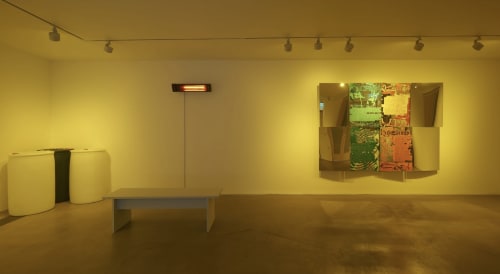Chan uses film, sound, and installation to consider the relationship between climate and culture, and its ramifications on society. In “Future Tropics,” he speculates on the tropical imaginary and the context, politics, and aesthetics of heat.
In the new spatial installation, Monsoons, a series of humidifiers and heat lamps create a microclimate in the gallery space. Mimicking the hot and humid climatic conditions of the tropics, they turn on and off, recreating seasonal shifts of weather. These devices upend the traditional climate-control systems of Western museums, where cool and dry conditions are imperative, and where order and systems reign. Under a warm hue of yellow light an endless summer lingers where days and nights, geographies, histories, and cultures all blur into one.
These conditions are narrated in Future Tropics (2023), a new film by Chan that speculates upon the ramifications of earth’s warming and consequent loss of climate variation. The film pushes observations of tropical expansion to their extreme ends. It follows fictional characters as they explore future societies and environs, ultimately asking the questions “if the entire world turned tropical, what would it mean to have an Old and New Tropics? How would our global culture and geopolitical relations be reshaped in a mono-climatic world?”
Alongside the film, is a presentation of Warm Fronts (2021–ongoing), a series of transmissions from across the tropics that tap into electronic music’s long-held associations as forms of futurist statement. Displayed over four screens are sets by musicians from different regions of the tropics (Guillerrrrmo [Brazil], Makossiri [Kenya], Kaleekarma [India], Gabber Modus Operandi [Indonesia]). Together they create a sonic and solar alliance built upon their shared histories and the connectivity of heat. Accompanying this are four posters introducing a micro-fiction inspired by each performer that foretell a radical tropical future.
The tropics are expanding, they cover almost 40% of the Earth’s surface area, and by 2050 more than half of the world’s population will live there. “Future Tropics” situates this zone within a future tense, a place of possibility and imagination, at-odds with the global narrative of the region being behind and out-of-time. Chan’s prescient work expands our geoclimatic imagination as we move towards a post-climatic world.


